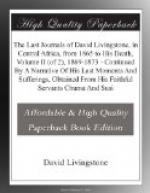By the arrival of the fast Ramadan on the 14th November, and a Nautical Almanac, I discovered that I was on that date twenty-one days too fast in my reckoning. Mr. Stanley used some very strong arguments in favour of my going home, recruiting my strength, getting artificial teeth, and then returning to finish my task; but my judgment said, “All your friends will wish you to make a complete work of the exploration of the sources of the Nile before you retire.” My daughter Agnes says, “Much as I wish you to come home, I would rather that you finished your work to your own satisfaction than return merely to gratify me.” Rightly and nobly said, my darling Nannie. Vanity whispers pretty loudly, “She is a chip of the old block.” My blessing on her and all the rest.
It is all but certain that four full-grown gushing fountains rise on the watershed eight days south of Katanga, each of which at no great distance off becomes a large river; and two rivers thus formed flow north to Egypt, the other two to Inner Ethiopia; that is, Lufira or Bartle Frere’s River, flows into Kamolondo, and that into Webb’s Lualaba, the main line of drainage. Another, on the north side of the sources, Sir Paraffin Young’s Lualaba, flows through Lake Lincoln, otherwise named Chibungo and Lomame, and that too into Webb’s Lualaba. Then Liambai Fountain, Palmerston’s, forms the Upper Zambesi; and the Lunga (Lunga), Oswell’s Fountain, is the Kafue; both flowing into Inner Ethiopia. It may be that these are not the fountains of the Nile mentioned to Herodotus by the secretary of Minerva, in Sais, in Egypt; but they are worth discovery, as in the last hundred of the seven hundred miles of the watershed, from which nearly all the Nile springs do unquestionably arise.
I propose to go from Unyanyembe to Fipa; then round the south end of Tanganyika, Tambete, or Mbete; then across the Chambeze, and round south of Lake Bangweolo, and due west to the ancient fountains; leaving the underground excavations till after visiting Katanga. This route will serve to certify that no other sources of the Nile can come from the south without being seen by me. No one will cut me out after this exploration is accomplished; and may the good Lord of all help me to show myself one of His stout-hearted servants, an honour to my children, and, perhaps, to my country and race.
Our march extended from 26th December, 1871, till 18th February, 1872, or fifty-four days. This was over 300 miles, and thankful I am to reach Unyanyembe, and the Tembe Kwikuru.
I find, also, that the two headmen selected by the notorious, but covert slave-trader, Ludha Damji, have been plundering my stores from the 20th October, 1870, to 18th February, 1872, or nearly sixteen months. One has died of small-pox, and the other not only plundered my stores, but has broken open the lock of Mr. Stanley’s storeroom, and plundered his goods. He declared that all my goods were safe, but when the list was referred to, and the goods counted, and he was questioned as to the serious loss, he at last remembered a bale of seven pieces of merikano, and three kanike—or 304 yards, that he evidently had hidden. On questioning him about the boxes brought, he was equally ignorant, but at last said, “Oh! I remember a box of brandy where it went, and every one knows as well as I.”




